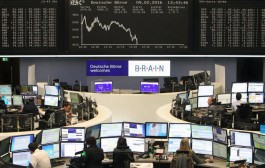Oil prices ended higher on Friday, as Hurricane Harvey threatened to disrupt production and refinery activity along the Gulf Coast.
About 25% of U.S. Gulf of Mexico oil production was offline due to storm activity, the U.S. Department of the Interior's Bureau of Safety and Environmental Enforcement said on Saturday. That equates to approximately 428,568 barrels of oil per day out of the roughly 1.75 million bpd pumped from the Gulf.
Around 112 platforms have been evacuated in the Gulf so far as a result of Harvey, about 15% of those in the region. Half of the drilling rigs in the Gulf have also been evacuated, BSEE said.
Prices received additional support after an update from oilfield services firm Baker Hughes showed its weekly count of oil rigs operating in the U.S. fell for the second time in row, by four rigs to a total of 759.
The weekly rig count is an important barometer for the drilling industry and serves as a proxy for oil production and oil services demand.
The U.S. West Texas Intermediate crude October contract tacked on 44 cents, or around 0.9%, to end at $47.87 a barrel by close of trade.
Elsewhere, on the ICE Futures Exchange in London, Brent oil for October delivery advanced 37 cents, or about 0.7%, to settle at $52.41 a barrel.
The rise in oil prices on Friday failed to offset losses sustained earlier in the week, as crude futures slipped to their fourth-straight weekly loss.
New York-traded crude ended the week down 64 cents, or nearly 1.3%, while the global Brent benchmark shed 31 cents, or roughly 0.6%.
Oil prices have been under pressure in recent weeks as concern over rising U.S. shale output canceled out production cuts by OPEC and non-OPEC members.
OPEC and 10 producers outside the cartel, including Russia, agreed since the start of the year to slash 1.8 million barrels per day in supply until March 2018 in order to reduce a global supply glut and rebalance the market.
So far, the deal has had little impact on global inventory levels due to rising supply from producers not participating in the accord, such as Libya and Nigeria, as well as a relentless increase in U.S. shale output.
Because of soaring U.S. output, the discount of WTI crude to Brent rose to its widest in almost two years at $4.54 per barrel.
Elsewhere on Nymex, gasoline futures for September inched up 0.2 cents, or about 0.2%, to end at $1.666 on Friday, but that represented a hefty retreat from the nearly five-month highs of $1.740 seen earlier in the session. It closed around 2.6% higher for the week.
Meanwhile, September heating oil edged up by less than 0.1% to $1.622 a gallon, ending around 0.1% higher on the week.
Natural gas futures for September delivery shed 5.0 cents, or 1.9%, to settle at $2.892 per million British thermal units, little changed for the week.
In the week ahead, market participants will eye fresh weekly information on U.S. stockpiles of crude and refined products on Tuesday and Wednesday to gauge the strength of demand in the world’s largest oil consumer.
Meanwhile, traders will also continue to pay close attention to comments from global oil producers for evidence that they are complying with their agreement to reduce output this year.
Ahead of the coming week, Investing.com has compiled a list of these and other significant events likely to affect the markets.
Tuesday, August 29
The American Petroleum Institute, an industry group, is to publish its weekly report on U.S. oil supplies.
Wednesday, August 30
The U.S. Energy Information Administration is to release weekly data on oil and gasoline stockpiles.
Thursday, August 31
The U.S. government is set to produce a weekly report on natural gas supplies in storage.
Friday, September 1
Baker Hughes will release weekly data on the U.S. oil rig count.
investing.com







































